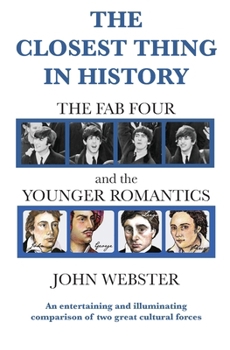The Closest Thing in History: The Fab Four and the Younger Romantics
'The Closest Thing in History' brings the eras of the Romantics and The Beatles together, arguing that The Beatles were a kind of exploded version of the quartet Keats, Byron, Leigh Hunt and Shelley. Opening by laying lout some broad similarities between them, John Webster first examines how the two groups' early mentors, William Wordsworth and Elvis Presley and William Wordsworth firstly galvanised them and then turned against them. Then, looking at their experiences of inspiration, he shows how we find John Lennon echoed Shelley's thinking, and Paul McCartney tuning in to mysterious creative visitations much like Keats. The first section ends with a comparison of Beatlemania and 'Byron-mania', noting how Lord Byron had a female following much like the Beatles and showing how both tapped into hidden but heartfelt social reservoirs of feeling.
The middle section then tells the story of the Romantics and their interlocking relationships, bringing in Beatles parallels in the process. Leigh Hunt is presented as a kind of Ringo figure, less of a creative force than the others but a vital supportive figure throughout, the fates of abandoned wives Harriet Shelley and Cynthia Lennon are put side by side, Shelley's 'Prometheus Unbound' is cast as a forerunner of the Beatles' 'Yellow Submarine', and their Apple Corps project finds a historic echo in the Romantics' publishing project from Pisa, 'The Liberal'.
These kinds of equivalences are more fully explored in the final section, which traces the legacy of the Romantics, noting that poetry as a popular force has largely been replaced by the newer force of rock 'n' roll, and suggesting that the Romantics reveal how The Beatles could go down in history.
John Webster's tantalising book offers original insights and telling perspectives on two great cultural forces. It will be of interest to Beatles fans, scholars and students of Romanticism, and those interested in the relationship between classic poetry and the newer force of rock 'n' roll.





